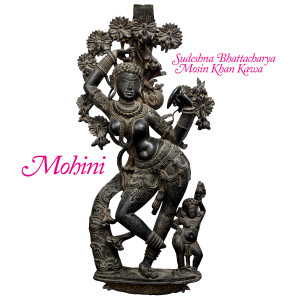 The first time I settled myself to listen closely to Mohini, there came a moment in the midst of the third piece, “Raga Bhairavi,” when a small embellishment made by Sudeshna Bhattacharya on her sarod made my heart soar. I no longer know at what point it came during this short (8:30) raga, and in fact the idea of recapturing the feeling of that moment is antithetical to the whole concept of raga. But it elicited joy and well being in me at that moment, with the promise that another time, with this raga or some other, I will be similarly uplifted.
The first time I settled myself to listen closely to Mohini, there came a moment in the midst of the third piece, “Raga Bhairavi,” when a small embellishment made by Sudeshna Bhattacharya on her sarod made my heart soar. I no longer know at what point it came during this short (8:30) raga, and in fact the idea of recapturing the feeling of that moment is antithetical to the whole concept of raga. But it elicited joy and well being in me at that moment, with the promise that another time, with this raga or some other, I will be similarly uplifted.
This raga, whose full title here is “Raga Mishra Bhairavi with Ragamala,” is often known as the queen of morning ragas, and it is frequently played as the final part of a performance, as do Sudeshna Bhattacharya & Mosin Khan Kawa on Mohini. Bhattacharya plays the sarod, which looks rather like the more familiar sitar, but its neck is made of smooth wood or stainless steel and it has no frets, which requires greater precision on the part of the player and also allows more flexibility in playing microtones. She’s an internationally recognized master of the instrument currently residing in Norway, where she has taught advanced students at the Norwegian Academy of Music — and thus her appearance on this recording by Norway’s Motvind label.
Mosin Khan Kawa is a top tabla player from Jaipur, India, who currently plays in a trio, and has played and toured extensively with his older brother Shahid Hussain Kawa. His presence adds immensely to the performances captured here, but the focus is rightly on Sudeshna. She is also listed as playing the droning tanpura and indeed you can hear it in several places, but I’m not sure how that was accomplished.
In addition to the closing “Raga Bhairavi,” the program begins with the revered classical “Raga Bhimpalasi,” the longest at just over 20 minutes; and “Raga Hamsadhvani,” the middle piece at about half that time span. In general these are fairly short performances, and especially their opening “aalap” sections are briefer than you’ll generally find in classical performances. “Bhimpalasi” is an intriguing raga and scholars have written lengthy (and to me incomprehensible) essays about it. I greatly enjoy Sudeshna’s improvisations on it, though, finding many places where she incorporates what in rock guitar we’d call a “lick.”
The sweetly melodic “Hamsadhvani” is identified in Wikipedia as a Carnatic raga, although it seems Sudeshna mainly works in the Hindustani tradition; both musicians launch right into it after the briefest of aalaps, and Sudeshna’s playing is quite energetic and focused.
That’s about the limit of my ability to write about ragas. I certainly can’t discuss this recording or any other in very learned terms, but I can tell you that it’s a superb recording of three performances that I find moving and invigorating. I’ll give the final word to Sudeshna, who explains the album’s title. Mohini is the feminine version of Krishna and symbolizes feminine strength – not in war, but in peace, love, and harmony. Amen to that.
(Motvind, 2025)
